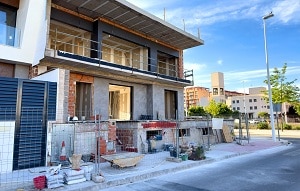
Business Advisory Services
Everything you need to help you launch your new business entity from business entity selection to multiple-entity business structures.
Table Of Contents

Posted Sunday, May 25, 2025
There are three primary situations when it comes to mortgage interest and other carrying costs during construction including renovations. There might be others, but here we go-
Let’s look at Treasury Regulations Section 1.266-1 first. The first paragraph reads in part-
(a)(1) In general. In accordance with section 266, items enumerated in paragraph
(b)(1) of this section may be capitalized at the election of the taxpayer.
Next, 1.266-1(b) reads-
(b) Taxes and carrying charges.
(1) The taxpayer may elect, as provided in paragraph (c) of this section, to treat the items enumerated in this subparagraph which are otherwise expressly deductible under the provisions of Subtitle A of the Code as chargeable to capital account either as a component of original cost or other basis, for the purposes of section 1012, or as an adjustment to basis, for the purposes of section 1016(a)(1). The items thus chargeable to capital account are:
(i) In the case of unimproved and unproductive real property: Annual taxes, interest on a mortgage, and other carrying charges.
(ii) In the case of real property, whether improved or unimproved and whether productive or unproductive:
(a) Interest on a loan (but not theoretical interest of a taxpayer using his own funds),
(b) Taxes of the owner of such real property measured by compensation paid to his employees,
(c) Taxes of such owner imposed on the purchase of materials, or on the storage, use, or other consumption of materials, and
(d) Other necessary expenditures, paid or incurred for the development of the real property or for the construction of an improvement or additional improvement to such real property, up to the time the development or construction work has been completed. The development or construction work with respect to which such items are incurred may relate to unimproved and unproductive real estate whether the construction work will make the property productive of income subject to tax (as in the case of a factory) or not (as in the case of a personal residence), or may relate to property already improved or productive (as in the case of a plant addition or improvement, such as the construction of another floor on a factory or the installation of insulation therein).
Yawn. Let’s break this down a bit into chunks to make some sense of it all.
First, the phrase “chargeable to capital account” generally means the expense may be capitalized and added to the cost basis of the rental property. In turn, this capitalized expense may be depreciated over time.
Second, there is a slight distinction between raw land that is unimproved and unproductive, and other real property that might be improved or unimproved, and might be productive or unproductive. This is a subtle distinction but can be read as new construction and renovations.
Third, note that Section 1.266-1(b)(1)(ii), the renovations part if you will, has a catchall “other necessary expenditures.” This would naturally include insurance and utilities, on top of mortgage interest and property taxes.
Fourth, if you read beyond what is detailed here, the term “project” is used frequently. Treasury Regulations 1.266-1 define “project” as-
For purposes of this section, a project means, in the case of items described in paragraph (b)(1)(ii) of this section, a particular development of, or construction of an improvement to, real property, and in the case of items described in paragraph (b)(1)(iii) of this section, the transportation and installation of machinery or other fixed assets.
Why should you care about this gibberish? Recall that if the rental property is not in service (ready and available for occupancy, and held out for rental use), it reverts to an investment property or a second home, and you are severely limited on tax deductions. Property taxes and mortgage interest might be limited. Insurance, utilities and HOA dues, and related expenses, are all suddenly non-deductible. Bummer.
However, if your rental property is taken offline for renovations, the expenses above are generally deductible as operating expenses if your intent is to continue holding the property to produce income. Sure, they might be again limited because of passive activity loss limitations, but they are either deductible when you have net rental income (profits) or when you sell the property.
So, how can you find yourself in a pickle? If you purchase a rental property and immediately start renovations, you will need the benefit of IRC Section 266 to capitalize these expenses for later depreciation and deduction.
Mechanics of How This Works
The mechanics of capitalizing certain carrying costs during construction or renovations takes a bit of math. Let’s say you are renovating a kitchen immediately after closing and the rental property is unavailable for 64 days. This is about 17.5% of the year, with the inverse being 82.5% as in-service time (yeah, we are assuming a Jan 1 purchase date which is a bit unrealistic, but whatever). Here is a table showing the math-
| Expense | Amount | % | OpEx | CapEx |
| Advertising | 1,500 | 100.0% | 1,500 | |
| Management Fees | 2,800 | 100.0% | 2,800 | |
| Mortgage Interest | 19,300 | 82.5% | 15,923 | 3,378 |
| Tax – Property | 7,600 | 82.5% | 6,270 | 1,330 |
| Tax – Sales | 3,400 | 100.0% | 3,400 | |
| Utilities | 4,800 | 82.5% | 3,960 | 840 |
| Total Capitalized | 5,548 |
Some items to note- “OpEx” is nerdy accounting speak for operating expenses, and “CapEx” refers to capital expenditures (not expenses). Yeah, sure, CapEx usually refers to buying something bigger, better, shiny and new, but it is fun to say OpEx and CapEx when illustrating the effects.
Next, certain expenses will remain 100% operating expenses such as advertising, management fees, sales tax, among others, since these expenses were incurred during the rental property’s in-service period.
Let’s say you spend $60,000 on the kitchen renovation. You would book the asset on your tax return’s fixed asset listing as $65,548 with the $5,548 representing the capitalized carrying costs.
Here is a sample election ripped off from our tax software that is attached to a timely filed tax return including extensions-
Pursuant to Internal Revenue Code § 266 and Treasury Regulation § 1.266-1(b), the taxpayer elects to capitalize carrying charges incurred during the taxable year [e.g., 2024] for the following property:
Property Address: [Insert rental property address]
The taxpayer is capitalizing the following types of carrying charges related to the above property:
Utilities (e.g., electricity, gas, water)
Insurance
Mortgage interest
Property taxes
Maintenance and security expenses
These costs were incurred prior to the property being placed in service for rental use, and are being capitalized to the basis of the property under this election.
Riveting.
Here is an example of a small work-around. Let’s say you take the rental property offline for two weeks to replace the carpet with tile since carpet is generally gross in a rental environment. The cost is $15,000, and you’ve calculated another $1,200 in carrying costs.
Assuming this tile renovation does not qualify for any repair safe harbor (de minimis, small taxpayer, routine maintenance) and it likely does not, you would record a $16,200 asset associated with the rental property. Would this tile renovation be eligible for bonus depreciation or Section 179 expensing? Typically, No, since tile is mortared to the floor structure and considered attached, and therefore would be depreciated over the life of the building.
Ok. Let’s say that carpeting is not that gross in a rental environment since you never use the property personally, and you spend $16,200 replacing it (that would be some fancy carpeting, but let’s roll with it). Good news! According to IRS Publication 948 How To Depreciate Property, this carpeting asset would generally be considered 5-year property and eligible for bonus depreciation and possibly Section 179 expensing should your rental property activity be considered a trade or business (regular and continuous involvement with a profit motive). See our accelerated depreciation and Section 179 deduction section on page 287 for more information.
Do you want more? Of course you do! Some people argue that carpeting in a basement is glued down versus tacked down, and is more aligned with tile in our example above. In other words, it is attached to the floor structure of the foundation and basement concrete.
As you can see, this gets tricky.
We can see your wheels turning already- you take the rental property offline for six months to replace a couple of light bulbs. Since your family is helping, you call this a project, and capitalize otherwise non-deductible expenses for later depreciation. Of course, this is facetious and dripping with sarcasm, but at the same time whether you are stuck with non-deductible expenses or you elect to capitalize these same expenses as carrying costs under IRC Section 266 is the million-dollar question.
As mentioned elsewhere, the time between when you close on the rental property and get the property ready and available for rent is no-man’s land. Must we now say no-person’s land? No landlord’s land is a mouthful. Regardless, this period of time between purchase and in-service date needs to be as small as you can make it since some rental property expenses are either limited or non-deductible because they don’t qualify as carrying costs (bad), or you need to be claiming renovations where these expenditures are capitalized (not good, but better).
Sidebar: As a reminder, the in-service date is not your first rented day. It is the date that the rental property is ready and available for occupancy, and held out for rental use through advertising and related efforts. This makes sense- the asset is deployed for its intended purpose. See our rental property in service defined section on page 85 for more information.
